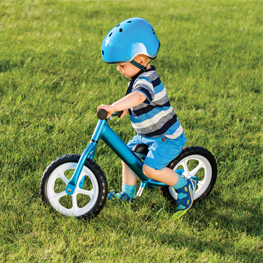
Want to encourage a lifetime of fitness, fun, and freedom? Bicycling offers all three, and today’s young riders are safer than ever. Per government statistics, kids’ fatalities from bike accidents have dropped 62 percent since 1999. But that doesn’t mean you should turn your kid loose on two wheels without proper preparation. Bike-related accidents still send over 240,000 kids to the emergency room each year - 26,000 of those have traumatic brain injuries. Here’s how to get your tots, teens, and in-betweens rolling safely.
Early Years
0 to 5: Balancing Act
Training wheels and trikes aren’t the only options for toddlers who want to ride. These days, more children are hopping on balance bikes - two-wheeled bikes without pedals - to get up to speed before graduating to a pedal bicycle. Balance bikes can help kids as young as 18 months build strength and confidence, and these bikes may assist your child in riding a traditional bike sooner. “Balance bikes are really easy to use, and there’s no learning curve!” says Richard Giorgi, founder of Carrboro, a nonprofit organization teaching bicycle repair and maintenance, and helping community members earn bicycles. “Balance bikes are stable. They don’t rock side-to-side or tip over, and the child always has their feet on the ground,” he says.
Pick a balance bike based on your child’s height. Proper fit allows kids to straddle the bike easily and keep both feet solidly on the ground. Giorgi recommends wooden balance bikes with solid wheels. “It’s not about speed, it’s about learning and stability. Heavier and more solid is okay; they’re not made to roll fast.”
Elementary Years
6 to 12: Ready, Set, Roll!
While some kids are happily riding a two-wheeled bike by first grade, others need more practice and support to feel confident on a bike. If your child is a reluctant rider, don’t give up, says Giorgi. Keep practice sessions fun and brief - a few minutes of enthusiastic practice is more effective than a long, forced lesson - and let your child choose a helmet and bike they love. Since safety slip-ups can cause major setbacks for already hesitant kids, take a few minutes to make sure your child’s bike sessions are drama-free.
Northwestern Medicine’s ThinkFirst Injury Prevention Program recommends tying up shoelaces that could get caught in spokes, insisting on covered-toe shoes (no riding barefoot or in sandals), and teaching kids to ride single-file, never side-by-side.
Hesitant children will feel more confident on a bike that fits well, and your child may outgrow their bike sooner than you think. By age 7 or so, many children are ready to move into a 20-inch bicycle and hand the ‘kid size’ 16-inch bike to a younger sibling or neighbor. A quick visit to a local bike shop will help match your child with the right size.
Teen Years: 13 to 18
Noggin Nation
Bigger bikers take bigger risks: While kids ages 10 to 14 have more bike-related ER visits than older teens, riders ages 15 to 19 account for more than half of bike-related deaths. The vast majority (88 percent) of teen bike fatalities are boys. Since your teen probably rides with minimal adult supervision, it’s vital to instill sound helmet habits to keep teens safe, even out of parent’s sight. Start with fit: Per ThinkFirst, bike helmets should sit flat on the head (like a baseball cap with the brim pointed straight out), not tilted back, and fit snugly. Side straps should form a V, with the bottom point directly beneath the earlobe. You should be able to fit one finger inside a buckled strap, but no more.
Riding after dark or on slick, wet streets increases the risk of crash and injury, so ask teens to call for a ride if they’re out after dark or caught in the rain. Teens are old enough to take some responsibility for maintaining their bike; make regular wheel, frame, drivetrain, and brake checks part of your teen’s regular bike-care routine for years of safe, two-wheeled fun.
Malia is a nationally-published health and parenting journalist.
Calgary’s Child Magazine © 2024 Calgary’s Child